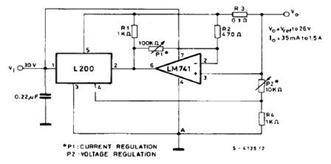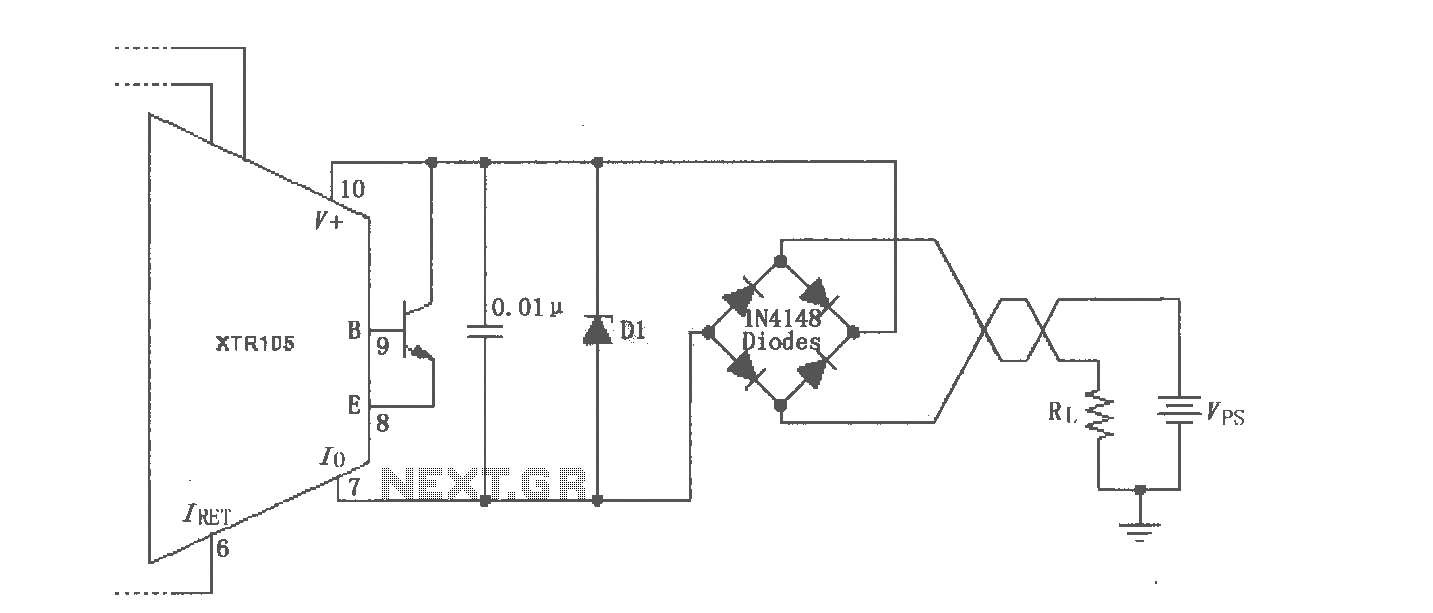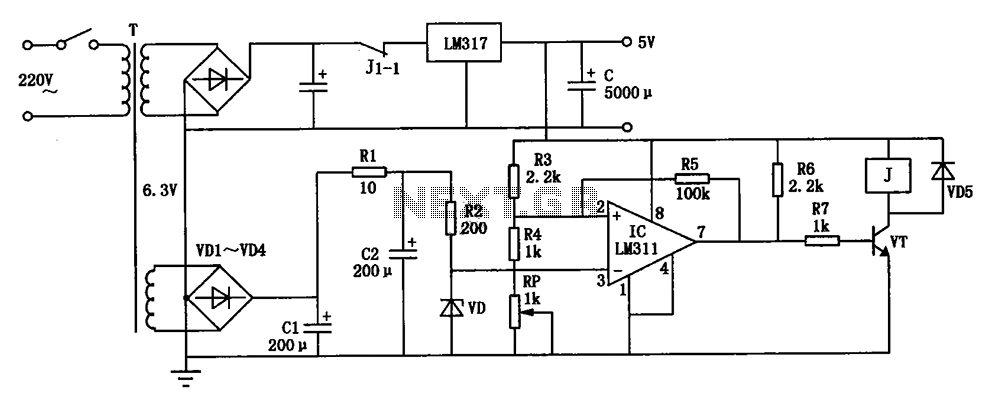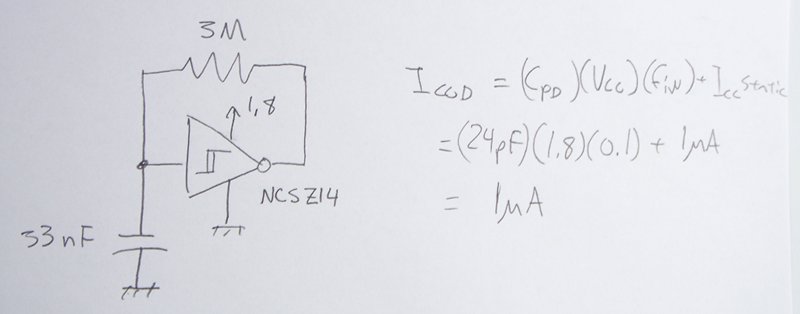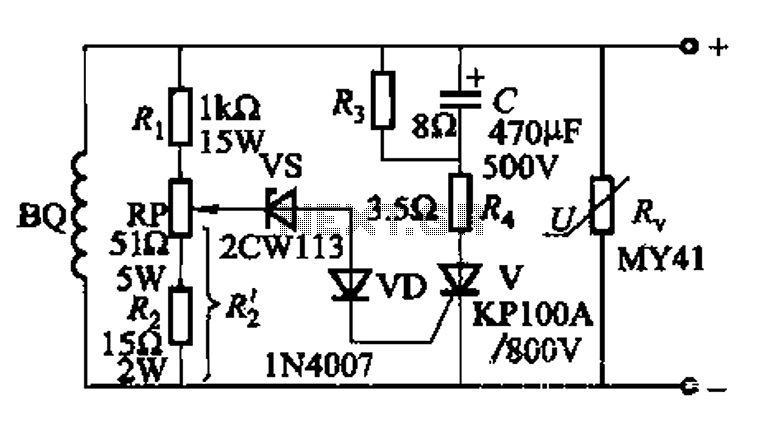
Two-LED Voltage Indicator
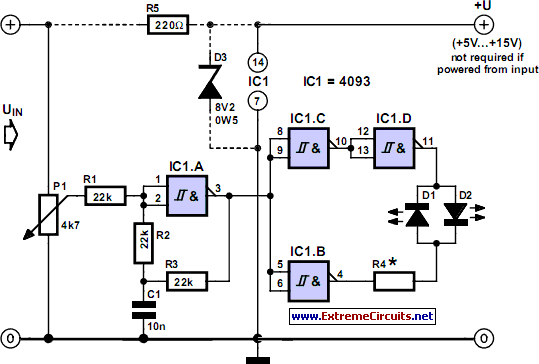
Many applications do not require the precision of a digital or analog (bar graph) indicator but still benefit from more than a simple low/high signal. An example is a battery charge level indicator in a car. This basic circuit, which utilizes two LEDs (ideally one green and one red in a single package), a low-cost CMOS IC type 4093, and a few resistors, can fulfill various such requirements. With an appropriate sensor, the indicator can display the relevant quantity through a color gradient from red to orange, yellow, and green. IC1.A operates as an oscillator at approximately 10 kHz based on the specified component values, although this frequency is not critical. Assuming R1 is not commented out, the output of IC1.A is a square wave with nearly a 50% duty cycle. The voltage at the junction of R2 and C1 will resemble a triangular wave, influenced by the difference in the two threshold voltages of the NAND Schmitt trigger gate IC1.A. IC1.B, IC1.C, and IC1.D serve as inverting and non-inverting buffers, causing the outputs of IC1.C and IC1.D to switch in a complementary manner. With a 50% duty cycle, both the red and green LEDs will illuminate for equal durations, producing an orange-yellow display. When R1 is integrated into the circuit, the input voltage to IC1.A will consist of the triangular waveform superimposed on the DC input voltage (Vin). As the input voltage fluctuates, the oscillator's duty cycle will change, resulting in either the red or green LED being on for longer periods, thus altering the visible color of the combined LED. The effective range for this color change is determined by the relative values of R1 and R2, allowing the circuit to be adapted to various supply voltages. With the specified component values and an 8-volt supply, the LED will transition from fully red at 2.5 V to fully green at 5.6 V. To monitor a car battery voltage, the battery can power the circuit, provided a zener diode and a dropper resistor are included to stabilize the IC supply voltage, as indicated by dashed outlines in the circuit diagram. Using an 8.2 V zener, the dropper resistor should be approximately 220 ohms, and R1 must be adjusted to 4.7 k ohms. The brightness of the LED is determined by R4, which can be approximated by the formula R4 = (Vsupply - 2) / 3[k]. It is important to note that the 4093 can only supply a limited output current of a few milliamperes. Potential applications for this simple circuit include non-critical uses such as go/no-go battery testers, basic temperature indicators, and water tank level indicators.
This circuit utilizes the CMOS 4093 IC, which contains four NAND gates configured as Schmitt triggers, allowing for clean transitions and stable oscillation. The primary oscillator function is achieved through the configuration of IC1.A, where the frequency can be adjusted by varying the resistor values. The triangular waveform generated at the junction of R2 and C1 is pivotal for controlling the LED color output. The complementary outputs from IC1.C and IC1.D ensure that the LEDs are driven in a manner that visually represents the charge level through color mixing.
The use of a zener diode in conjunction with a dropper resistor is essential for maintaining a stable supply voltage to the IC, especially when the circuit is powered directly from the car battery. This ensures consistent operation across varying battery voltages. The circuit's adaptability to different supply voltages is a significant advantage, allowing it to be used in various applications beyond battery monitoring, such as simple indicators for temperature or liquid levels.
The design emphasizes simplicity and low cost, making it suitable for hobbyist projects and educational purposes. The ability to visually indicate varying levels through color change provides an intuitive understanding of the monitored parameter, enhancing user experience. The circuit can be further refined or expanded by incorporating additional sensors or modifying component values to tailor its performance to specific applications.There are many applications where the accuracy of a digital or analogue (bar graph) is not required but something better than a simple low/high indicator is desirable. A battery charge level indicator in a car is a good example. This simple circuit requiring only two LEDs (preferably one with a green and red LED in a single package), a cheap CMOS
IC type 4093 and a few resistors should ful-fil many such applications. With a suitable sensor, the indicator will display the relevant quantity as a colour ranging from red through orange and yellow to green. IC1. A functions as an oscillator running at about 10 kHz with the component values given, although this is not critical.
Assuming for the moment that R1 is not commented, the output of IC1. A is a square wave with almost 50% duty cycle. The voltage at the junction of R2 and C1 will be a triangular wave (again, almost) with a level determined by the difference in the two threshold voltages of the NAND Schmitt trigger gate IC1. A. IC1. B, IC1. C and IC1. D form inverting and noninverting buffers so that the outputs of IC1. C and IC1. D switch in complementary fashion. With a 50% duty cycle, the red and green LEDs will be driven on for equal periods of time so that both will light at approximately equal brightness resulting in an orange-yellow display.
With R1 in circuit, the actual input voltage to IC1. A will consist of the triangular waveform added to the dc input Vin. As the input voltage varies, so will the oscillator duty cycle causing either the red or the green LED to be on for longer periods and so changing the visible colour of the combi-LED. The actual range over which the effect will be achieved is determined by the relative values of R1 and R2, enabling the circuit to be matched to most supply voltages.
With the component values given and a supply of 8 volts, the LED will vary from fully red to fully green in response to input voltages of 2. 5 V and 5. 6 V respectively. To monitor a car battery voltage, the battery itself could be used to power the circuit provided a zener diode and dropper resistor are added to stabilise the IC supply voltage.
This is shown in dashed outlines in the circuit diagram. With an 8. 2 V zener the dropper resistor should be around 220 and R1 has to be reduced to 4. 7 k. The LED brightness is determined by R4. As a rule of thumb, R4 = (Vsupply 2) / 3[k] and remember that the 4093 can only supply a few mA`s of output current. Applications of this little circuit include non critical` ones such as go/non-go battery testers, simple temperature indicators, water tank level indicators, etc.
🔗 External reference
This circuit utilizes the CMOS 4093 IC, which contains four NAND gates configured as Schmitt triggers, allowing for clean transitions and stable oscillation. The primary oscillator function is achieved through the configuration of IC1.A, where the frequency can be adjusted by varying the resistor values. The triangular waveform generated at the junction of R2 and C1 is pivotal for controlling the LED color output. The complementary outputs from IC1.C and IC1.D ensure that the LEDs are driven in a manner that visually represents the charge level through color mixing.
The use of a zener diode in conjunction with a dropper resistor is essential for maintaining a stable supply voltage to the IC, especially when the circuit is powered directly from the car battery. This ensures consistent operation across varying battery voltages. The circuit's adaptability to different supply voltages is a significant advantage, allowing it to be used in various applications beyond battery monitoring, such as simple indicators for temperature or liquid levels.
The design emphasizes simplicity and low cost, making it suitable for hobbyist projects and educational purposes. The ability to visually indicate varying levels through color change provides an intuitive understanding of the monitored parameter, enhancing user experience. The circuit can be further refined or expanded by incorporating additional sensors or modifying component values to tailor its performance to specific applications.There are many applications where the accuracy of a digital or analogue (bar graph) is not required but something better than a simple low/high indicator is desirable. A battery charge level indicator in a car is a good example. This simple circuit requiring only two LEDs (preferably one with a green and red LED in a single package), a cheap CMOS
IC type 4093 and a few resistors should ful-fil many such applications. With a suitable sensor, the indicator will display the relevant quantity as a colour ranging from red through orange and yellow to green. IC1. A functions as an oscillator running at about 10 kHz with the component values given, although this is not critical.
Assuming for the moment that R1 is not commented, the output of IC1. A is a square wave with almost 50% duty cycle. The voltage at the junction of R2 and C1 will be a triangular wave (again, almost) with a level determined by the difference in the two threshold voltages of the NAND Schmitt trigger gate IC1. A. IC1. B, IC1. C and IC1. D form inverting and noninverting buffers so that the outputs of IC1. C and IC1. D switch in complementary fashion. With a 50% duty cycle, the red and green LEDs will be driven on for equal periods of time so that both will light at approximately equal brightness resulting in an orange-yellow display.
With R1 in circuit, the actual input voltage to IC1. A will consist of the triangular waveform added to the dc input Vin. As the input voltage varies, so will the oscillator duty cycle causing either the red or the green LED to be on for longer periods and so changing the visible colour of the combi-LED. The actual range over which the effect will be achieved is determined by the relative values of R1 and R2, enabling the circuit to be matched to most supply voltages.
With the component values given and a supply of 8 volts, the LED will vary from fully red to fully green in response to input voltages of 2. 5 V and 5. 6 V respectively. To monitor a car battery voltage, the battery itself could be used to power the circuit provided a zener diode and dropper resistor are added to stabilise the IC supply voltage.
This is shown in dashed outlines in the circuit diagram. With an 8. 2 V zener the dropper resistor should be around 220 and R1 has to be reduced to 4. 7 k. The LED brightness is determined by R4. As a rule of thumb, R4 = (Vsupply 2) / 3[k] and remember that the 4093 can only supply a few mA`s of output current. Applications of this little circuit include non critical` ones such as go/non-go battery testers, simple temperature indicators, water tank level indicators, etc.
🔗 External reference

